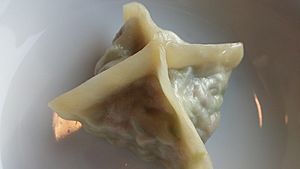Pyeonsu facts for kids
 |
|
| Type | Mandu |
|---|---|
| Place of origin | Korea |
| Region or state | Gaeseong |
| Associated national cuisine | Korean cuisine |
| Serving temperature | Chilled |
| Pyeonsu | |
| Hangul |
편수
|
|---|---|
| Revised Romanization | pyeonsu |
| McCune–Reischauer | p'yŏnsu |
| IPA | [pʰjʌn.su] |
Pyeonsu (Korean: 편수) is a special square-shaped mandu, which is a type of dumpling from Korean cuisine. It's often eaten in the summer, served cold, and dipped in a mix of soy sauce and vinegar. The city of Gaeseong in North Hwanghae Province is especially known for its delicious pyeonsu.
Contents
What is Pyeonsu?
Pyeonsu is a unique Korean dumpling. Unlike many other dumplings, it has a distinct square shape. It's known for being a refreshing dish, perfect for warm weather. People usually enjoy pyeonsu chilled, sometimes even floating in a cold broth.
The Story of Pyeonsu
Dumplings, or mandu, first came to Korea around the 14th century. They were brought by people from the Yuan dynasty (Mongolia). However, pyeonsu itself is thought to have come from Ming dynasty China. Korean merchants from Gaeseong likely brought these dumpling ideas to the Korean peninsula.
Why is Gaeseong Famous for Pyeonsu?
During the Joseon era (1392–1897), wheat flour was quite rare and expensive in most parts of Korea. But in Hwanghae Province, where Gaeseong is located, wheat was very common. This meant that people in Gaeseong could make their dumpling skins from wheat flour.
In poorer homes, pyeonsu was made with simple fillings like tofu and mung bean sprouts. Wealthier families in Gaeseong made fancy versions with beef and fresh oysters. A book from 1908, called Women's Encyclopedia, even mentions that pyeonsu from Gaeseong (then called Songdo) was famous and eaten during Korean New Year celebrations.
Unlike some other dumplings, pyeonsu didn't become popular all over Korea. It mostly stayed a special dish found in Gaeseong-style restaurants.
How is Pyeonsu Made?
Making pyeonsu involves a few steps, starting with the dough and then the filling.
Making the Dough
First, a dough is made by mixing wheat flour with hot, boiling water. This dough is then rolled out very thin. After that, it's cut into square shapes, which will become the wrappers for the pyeonsu dumplings.
What Goes Inside Pyeonsu?
The fillings for pyeonsu can vary. Common ingredients include different kinds of meat like beef, pork, chicken, or even pheasant meat. Vegetables are also popular, such as tofu, mung bean sprouts, and various mushrooms. Some versions even include oysters and a few whole pine nuts in each dumpling.
These fillings are seasoned to give them flavor. Cooks use salt, black pepper, ground toasted sesame, sesame oil, and finely chopped aromatic vegetables like scallions, ginger, and garlic.
Cooking and Serving Pyeonsu
Once the pyeonsu dumplings are filled and shaped, they are boiled. They are usually cooked in a broth made from beef and soy sauce. After boiling, the dumplings are chilled.
Pyeonsu can be served in a few ways:
- Chilled: They can be served as they are, or in a cold chicken broth. A dipping sauce made from soy sauce mixed with vinegar is usually served on the side.
- Warm Soup: Sometimes, pyeonsu is served warm as a soup called pyeonsu-guk. This warm soup often has gomyeong (garnishes) on top, like thin strips of egg garnish and chopped scallions.

